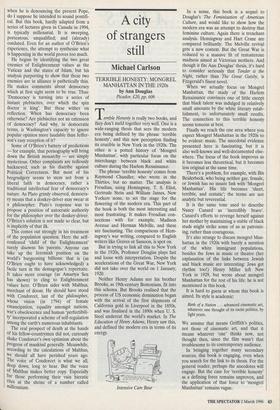A city of strangers still
Michael Carlson
TERRIBLE HONESTY: MONGREL MANHATTAN IN THE 1920s by Ann Douglas
Picador, £20, pp. 606
Terrible Honesty is really two books, and they don't meld together very well. One is a wide-ranging thesis that sees the modern era being defined by the phrase 'terrible honesty', and this new perception finding its crucible in New York in the 1920s. The other is a potted history of 'Mongrel Manhattan', with particular focus on the interchange between black and white culture during the Harlem Renaissance.
The phrase 'terrible honesty' comes from Raymond Chandler, who wrote in the Thirties, but no matter. The analysis is Freudian, using Hemingway, T. S. Eliot, Gertrude Stein and William James, New Yorkers none, to set the stage for the flowering of the modern era. This part of the book is both the most interesting and most frustrating. It makes Freudian con- nections with for example, Madison Avenue and Herman Melville, and these are fascinating. The comparisons of Hem- ingway's war writing, compared to English writers like Graves or Sassoon, is spot on.
But in trying to link all this to New York in the 1920s, Professor Douglas plays fast and loose with interpretation. Despite the accelerations of the Great War, New York did not take over the world on 1 January, 1920.
Neither Henry Adams nor his brother Brooks, as 19th-century Bostonians, fit into this schema. But Brooks realised that the process of US economic domination began with the arrival of the first shipments of California gold in Liverpool in the 1850s, and was finalised in the 1890s when U. S. Steel undercut the world's market. In The Education of Henry Adams, Henry saw this, and defined the modern era in terms of its energy. In a sense, this book is a sequel to Douglas's The Feminisation of American Culture, and would like to show how the modern era was an attempt to destroy that feminine culture. Again there is trenchant analysis. Hemingway and Hart Crane are compared brilliantly. The Melville revival gets a new context. But the Great War is reduced to a massive fit of testosterone madness aimed at Victorian mothers. And though it fits Ann Douglas' thesis, it's hard to consider seriously that Tender is the Night, rather than The Great Gatsby, is Fitzgerald's finest novel.
When we actually focus on Mongrel Manhattan, the study of the Harlem Renaissance convinces one of little except that black talent was indulged in relatively small amounts by the white literary estab- lishment, to unfortunately small results. The connection to this terrible honesty seems tenuous at best.
Finally we reach the one area where you expect Mongrel Manhattan in the 1920s to be evident: music. The anecdotal evidence presented here is fascinating, but it is also well-known and well-documented else- where. The focus of the book improves as it becomes less theoretical, but it becomes less original at the same time.
There's a problem, for example, with Bix Beiderbeck, who being neither gay, female, or Jewish has no innate link with `Mongrel Manhattan'. His life becomes 'short, terrible, and ecstatic'; the terms are not analytic but reverential.
It is the same tone used to describe Nancy Cunard as 'incredibly brave'. Cunard's efforts to revenge herself against her mother by maintaining a stable of black studs might strike some of us as patronis- ing, rather than courageous.
It's also strange to discuss mongrel Man- hattan in the 1920s with barely a mention of the white immigrant populations, besides the Jews in music or theatre (her explanation of the links between Jewish and black music are interesting: Jews got rhythm too!) Henry Miller left New York in 1929, but wrote about mongrel Manhattan for the rest of his life: he is not mentioned in this book.
It is hard to guess at whom this book is aimed. Its style is academic: Birth of a Nation . . . advanced cinematic art, whatever one thought of its racist politics, by light years.
We assume that means Griffith's politics, not those of cinematic art, and that it means whatever 'one' thinks now, not thought then, since the film wasn't that troublesome to its contemporary audience.
In bringing together many secondary sources, this book is engaging, even when you search for the link to its thesis. For the general reader, perhaps the anecdotes will engage. But the case for 'terrible honesty' as a defining force remains unproven, and the application of that force to 'mongrel Manhattan' remains vague.


































































 Previous page
Previous page